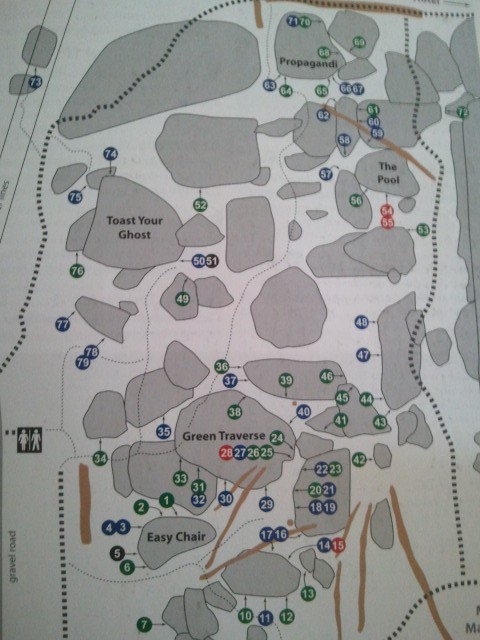We had been looking for Squamish Special for over an hour. We climbed over a bunch of talus then dropped down from a big boulder where you could tell everyone’s jumped down before because there was a bald spot at the bottom. I jump down, look up, and say, “fuuucckk.” As soon as you jump down, all you see in front of you in moss and nowhere to walk. No sign that anyone has moved forward from there. You know that everyone who has jumped down from that boulder has had this exact same feeling. Then they’ve had to turn around, climb back up and find their way back to the trail.
My brother was telling me this story about false trails in Squamish, British Columbia. The area is dense with talus, huge standing trees, huge fallen trees, brush, ferns, and moss. He and his friends have gone bouldering there the last few summers, and they use guide books to find new boulders to climb. The guides sound vague though because there are few distinguishing landmarks to follow. The book might say, “There will be a fallen tree next to the rock,” but here everything looks like that. Even the photos of the boulders in the book might be misleading. The pic might have been taken in winter and when you go in summer it’s going to look really different. My brother points to one and says, “You can’t even see this angle of the rock in August because the trails are overgrown. It wouldn’t look like this at all from the approach we’d be taking.” Here’s a description from the guide of how to reach a boulder called Vigilante found in the Smoke Bluffs:
To approach, start at the motorcycle trials signboard on the east side of the Smoke Bluffs parking lot. Follow the well-worn bike trail north for about 20 paces and turn right onto a faint trail that leads directly into the brush. Trend slightly right, eventually stepping up onto a small, vegetated granite slab. Walk about 25 paces south, over mossy rocks and through trees, toward the Boulder Gully talus field. A short mantel through a mossy slot on the left wall leads to a grassy ledge – the Vigilante boulder is directly above.
What ends up happening is that people will find a faint trail that more or less matches the description in the book and is more or less in the right place. They’ll continue down the path for 5 minutes, 10 minutes, maybe longer. Then all of a sudden the path will turn a corner around a tree and stop dead in the middle of a field of ferns. “This is sooo frustrating,” my brother tells me. You know exactly at that point that you’re on a false trail. That you have followed the mistakes of so many people before you. Every time someone treads on that path they make it more defined. So not only have you followed a false trail, but you have made it a little easier for someone else to make the same mistake.
I find this oddly comforting. When I have a problem or am lost, I feel like no one understands it the way I do. On a false trail, my problems are less unique. And knowing that my problems are not unique is really special. You’re not alone! Others, many others, have done it wrong in exactly the same way. It’s an apt metaphor for how we go about our day, trying to find our way, often going down the well-worn path that’s totally wrong for us. But always with the ability to turn around and go back.
I also love this as a nerd study in wear patterns. We leave our impression on the environments in which we live. This is visible evidence that many were there before us and many will follow after.
This is an example of how convoluted the “trails” can be. My brother says that it’s usually better to stick to the trails though and not try to cut across another way. There’s probably a really good reason they are where they are – the least heinous path.
To my untrained eye, I couldn’t tell this rock from Adam, let alone decide how it might change through the seasons. (Pages from Marc Bourdon’s Squamish Bouldering (2010).)
Scrambly paths…




Lovin this post. It’s nice that you take something positive out of these false trails. I only thought of it on the negative side, such as when you are driving and there is a detour and you don’t know where to go so you just follow the person in front of you assuming they do. Basically, we are sheep and blindly follow someone in front of us because it is easier. Yours is better though.
I feel like wear patterns are missing in a lot of non-natural manufactured objects and spaces. I think that might be why we find some visualizations and maps interesting. I was just thinking about wear patterns recently, as my computer has a pine wood veneer covering it. The pine is well-worn at the corners, but the computer looks exactly as it did when I bought it.
A co-working space designers that I spoke to was interested in creating a shared history in the wear patterns on the space’s furniture. At the time, it seemed like a contrived concept for such a new building. But, I find myself thinking of that conversation pretty often. I’m not sure if it’s because I want a nice place work, or a nice place to work that has history… or something else.